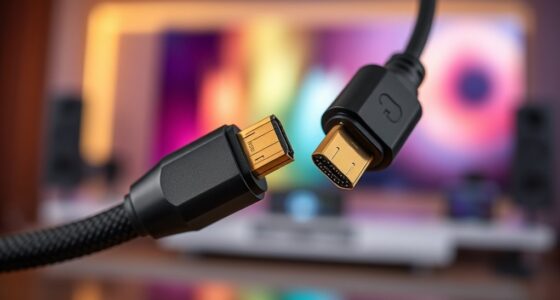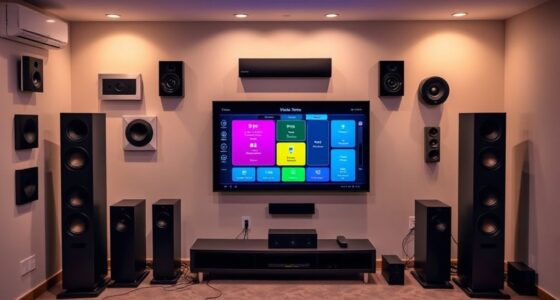Understanding EARC and ARC safety is key to enjoying high-quality audio without issues. Both use HDMI cables to transmit sound, but eARC offers higher bandwidth and faster, more reliable connections, reducing lag and supporting advanced formats like Dolby Atmos. It’s essential to connect compatible devices properly and use high-quality cables to avoid problems like audio dropouts or delays. Keep your equipment updated and configured correctly to guarantee safety and performance—continue with this guide to learn more.
Key Takeaways
- Proper setup with compatible HDMI cables and devices ensures safe and optimal audio/video performance.
- Using high-quality HDMI 2.1 cables minimizes risks like signal interference and connection issues.
- Power off devices before connecting or disconnecting to prevent electrical shorts or damage.
- Confirm device support for ARC or eARC to avoid compatibility problems and ensure safety.
- Regular firmware updates improve system stability, security, and safety in home entertainment setups.
What Are EARC and ARC?

Have you ever wondered how your high-quality audio and video signals travel seamlessly from your devices to your display? It’s all about the technology behind ARC and eARC. These are advanced audio return channels that transmit audio signals via HDMI cables. With ARC, you might experience issues like audio lag if the cable length is too long or if your setup isn’t optimized. eARC improves on this by offering faster, more reliable data transfer, reducing audio lag considerably. Both use HDMI ports, but eARC supports higher bandwidths for better sound quality and compatibility with modern audio formats. Understanding these differences helps you set up your system correctly, ensuring your audio and video signals arrive without delay or interference. Incorporating industry standards ensures optimal performance and compatibility across devices. Additionally, awareness of audio signal transmission principles can help troubleshoot common setup issues effectively, especially as cyber threats continue to evolve in the realm of digital audio and video systems. Moreover, staying informed about security vulnerabilities related to digital audio equipment can prevent potential cyber threats from affecting your entertainment setup.
Key Differences Between EARC and ARC

While both eARC and ARC enable audio transmission through HDMI, they differ markedly in performance and capabilities. eARC offers higher bandwidth, supporting advanced audio formats like Dolby Atmos and DTS:X, which ARC often struggles with due to its limited data transfer rate. eARC also provides better compatibility with wireless alternatives for surround sound systems, ensuring seamless audio quality. The table below highlights key differences:
| Feature | ARC | eARC | Wireless Alternatives |
|---|---|---|---|
| Bandwidth | Limited | High | Compatible for streaming high-quality audio |
| Supported Formats | Basic stereo, Dolby Digital | Advanced formats, Dolby Atmos, DTS:X | Enhances surround sound experiences |
| Compatibility | Older devices | Newer HDMI devices | Enables multi-room audio setup |
| Latency | Slight delay | Minimal delay | Reduces lag in wireless connections |
| Audio Quality | Good but limited | Superior, lossless | Offers reliable, high-fidelity sound |
A new sentence with digital audio formats and the rest of the sentence.
How EARC and ARC Transmit Audio
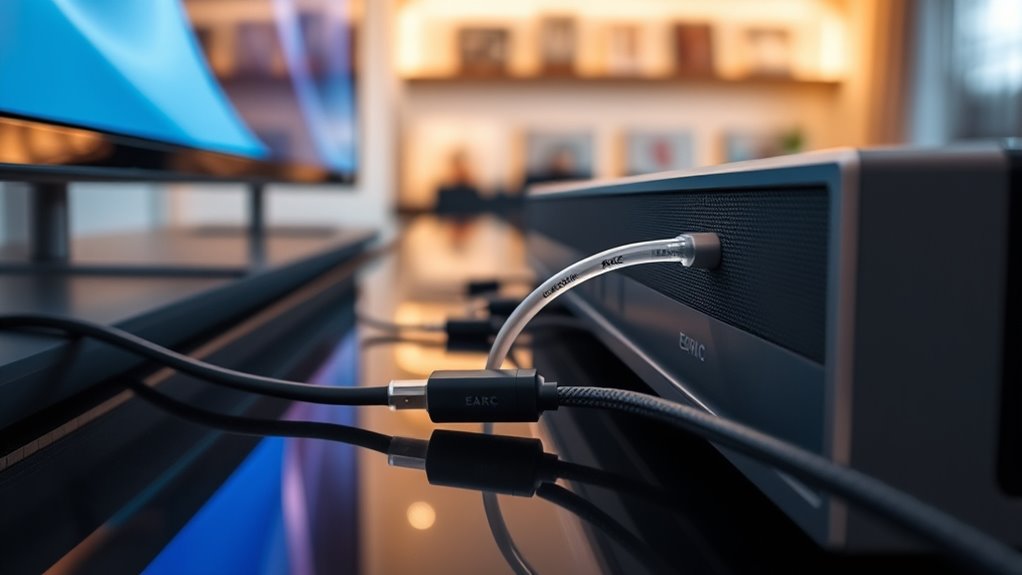
You’ll see that EARC and ARC transmit audio using different signal transmission methods and digital audio protocols. These differences affect how well each technology works with your devices. Understanding their digital audio protocols helps you determine compatibility and performance expectations. Additionally, the wireless transmission capabilities of EARC and ARC influence the ease of setup and overall audio quality. The choice between them can also be affected by the compatibility with your audio system, ensuring seamless integration across your home entertainment setup. Recognizing the importance of fidelity and latency can further assist in selecting the suitable technology for your needs. Moreover, signal stability plays a critical role in maintaining consistent audio quality during use.
Signal Transmission Methods
How do eARC and ARC transmit audio signals between devices? They mainly use wired connections, with HDMI being the standard method, guaranteeing a reliable, high-quality digital signal transfer. Wired transmission offers a direct, interference-free path for audio, making it ideal for high-fidelity sound. However, some setups also support wireless transmission, which provides convenience and flexibility, especially in modern smart homes. When considering analog versus digital, both ARC and eARC rely on digital signals, which preserve audio integrity better than analog. Digital transmission ensures clearer sound with less noise or degradation. While wired digital connections are common, wireless options are emerging, offering a versatile way to transmit audio without physical cables. Additionally, understanding the aromatherapy benefits can enhance your overall environment, whether through relaxation or mental clarity. For optimal performance, it’s important to consider compatibility between devices and their supported standards, ensuring seamless integration. Moreover, staying informed about industry standards helps in selecting the right equipment for your setup. Recognizing the signal transmission methods can help you make better decisions when designing your home entertainment system. Newer technologies also focus on enhanced audio quality, which greatly improves the listening experience. Ultimately, the choice depends on your setup and preference for wired or wireless, analog or digital transmission methods.
Digital Audio Protocols
Digital audio protocols like eARC and ARC facilitate the transfer of high-quality audio signals between devices through standardized digital communication methods. These protocols guarantee your audio remains clear and synchronized, whether wired or wireless. With wireless connectivity options, such as Bluetooth or Wi-Fi, audio data can be transmitted without physical cables, offering more flexibility. Both eARC and ARC support advanced audio codecs, enabling you to enjoy immersive sound experiences like Dolby Atmos or DTS:X. They prioritize efficient data transfer, minimizing latency and preserving audio fidelity. By using these protocols, your devices communicate seamlessly, ensuring your audio signals are transmitted accurately and reliably. This foundation allows modern home entertainment systems to deliver superior sound quality with ease and minimal setup. Understanding audio support features helps users optimize their device compatibility and performance. Additionally, compatibility with home theater systems enhances overall audio experience and simplifies integration, especially as these systems increasingly incorporate security zone info features to protect your connected devices. Moreover, understanding the personality traits of devices or user preferences can further enhance the tailored audio setup for your environment.
Compatibility With Devices
Since compatibility between devices is essential for seamless audio transmission, understanding how eARC and ARC interact with various equipment is crucial. Most modern TVs and soundbars support ARC, but eARC offers broader compatibility with newer devices, guaranteeing higher quality audio. Check if your devices have HDMI ARC or eARC ports; older models may only support basic ARC or lack the feature altogether. Understanding the differences between ARC and eARC can help you optimize your setup and ensure the best possible audio experience. While HDMI connections are primary, wireless alternatives like Bluetooth compatibility can supplement setups, especially for streaming audio directly from smartphones or tablets. Bluetooth offers convenient wireless audio, but it may introduce latency or reduce quality compared to HDMI. To ensure optimal performance, verify device compatibility and consider integrating wireless alternatives if needed, but remember that wired HDMI connections generally provide more reliable, higher-quality audio transmission. Additionally, understanding the differences between ARC and eARC can help you choose the best setup for your audio needs.
Compatibility and Device Requirements
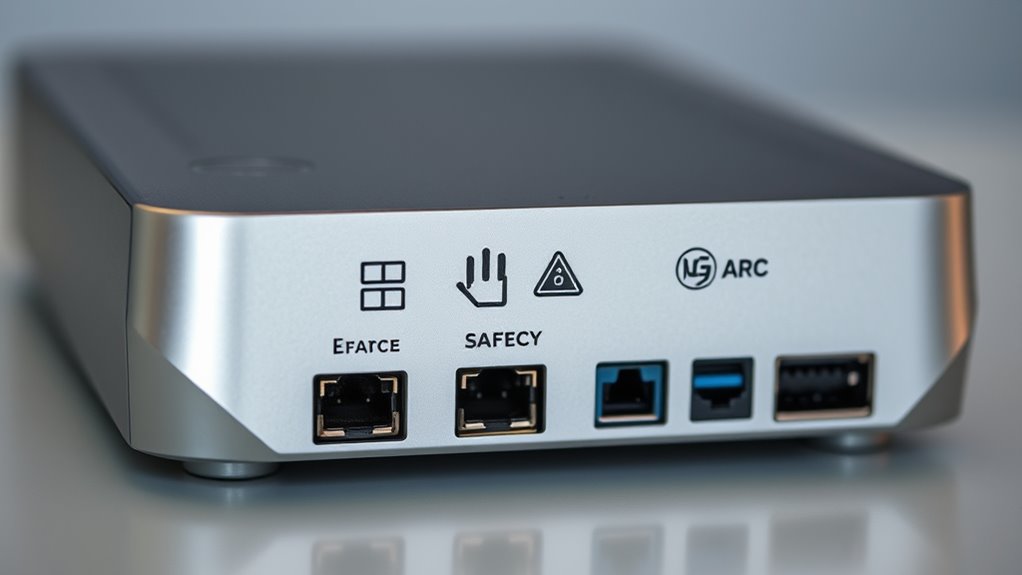
To use eARC or ARC, your devices need to meet specific compatibility standards. You should verify if your TV, soundbar, or receiver supports HDMI ARC or eARC, as not all models do. Additionally, confirm your hardware has the necessary features, like HDMI ports labeled for ARC or eARC, to enable proper audio transmission.
Device Compatibility Standards
Are your devices compatible with EARC and ARC standards? To guarantee seamless audio transmission, your equipment must support specific audio codecs like Dolby Atmos or DTS:X, which provide high-quality sound. Compatibility also depends on the device’s ability to handle wireless connectivity options, especially for wireless ARC systems. Modern TVs and soundbars typically list support for HDMI ARC or eARC in their specifications, but double-check that they meet the required standards. Keep in mind that older devices may lack support for the latest audio codecs or wireless features, limiting their compatibility. Making sure your devices align with these standards guarantees better audio performance and smoother integration within your home entertainment setup. Compatibility is essential for revealing the full potential of EARC and ARC technologies.
Required Hardware Features
Ensuring your devices support the necessary hardware features is essential for compatible EARC and ARC functionality. You need HDMI ports that specifically support these protocols, which often means checking for HDMI 2.1 for eARC or HDMI 1.4/2.0 for ARC. Devices must also handle audio delay effectively, minimizing lag between video and audio for seamless playback. Additionally, proper hardware enables volume control through your TV or remote, allowing you to adjust sound easily without needing multiple remotes. Without these hardware features, you might experience issues like inconsistent audio quality or unresponsive volume controls. Confirming your devices meet these requirements guarantees smooth, high-quality audio and video performance, making your home entertainment setup safer, more reliable, and more enjoyable.
Setting Up EARC and ARC Safely

Setting up EARC and ARC safely is essential to prevent audio issues and protect your equipment. Start by checking that your devices support the correct connection types, such as HDMI ARC or eARC, and verify they are compatible with your TV and sound system. Use high-quality HDMI cables that meet the required specifications for audio format transmission—preferably HDMI 2.1 for eARC. Connect your soundbar or AV receiver directly to the TV’s designated ARC or eARC port. Always power off devices before connecting to avoid short circuits. Once connected, turn on your devices and configure the audio settings to match the supported audio format. Proper setup ensures reliable audio transfer and minimizes the risk of damage to your equipment.
Common Issues and Troubleshooting Tips

Despite careful setup, issues with EARC and ARC can still occur, causing audio dropouts, delays, or no sound at all. These problems often relate to audio latency or device synchronization. To troubleshoot, try these steps:
- Check all connections to ensure they’re secure and compatible.
- Restart your devices to reset the audio handshake.
- Update firmware on your TV, soundbar, or AV receiver for ideal device synchronization.
- Disable and re-enable CEC or ARC settings to resolve audio latency issues.
If problems persist, consider testing with different cables or reducing the audio processing features that may introduce delays. Addressing these common issues helps restore smooth audio performance and maintains proper device synchronization.
Best Practices for Optimal Sound Quality
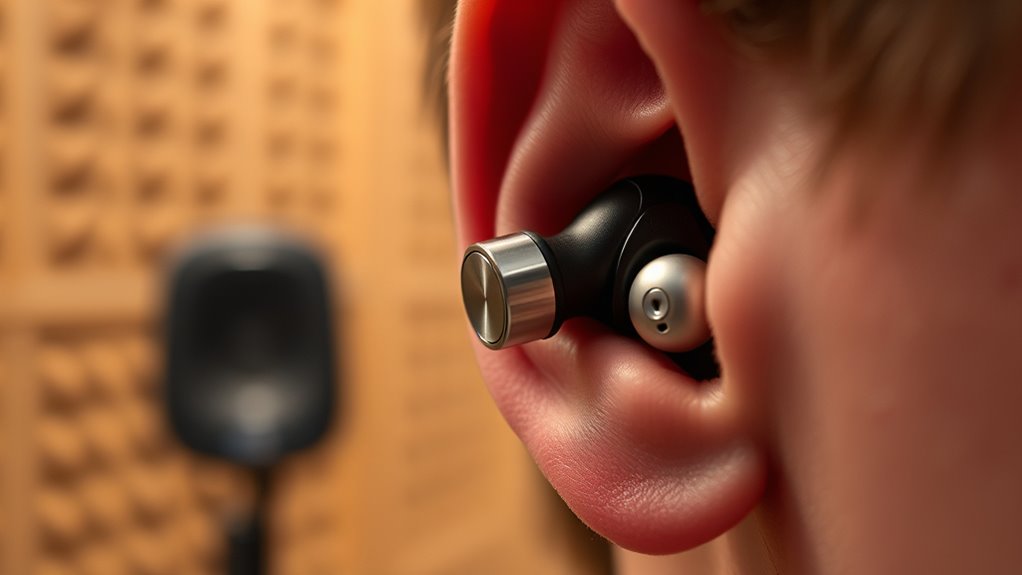
For the best sound quality, it’s essential to optimize your audio setup by using the right cables and configurations. To minimize audio latency, guarantee your connections are secure and compatible, especially if you’re using ARC or eARC. Wired connections often provide lower latency compared to wireless connectivity, which can introduce delays that affect synchronization. If you’re relying on wireless, choose devices with robust Wi-Fi or Bluetooth standards to improve stability. Keep firmware updated on all devices to prevent compatibility issues, and avoid daisy-chaining multiple devices that could increase latency. Properly configuring your audio settings, such as enabling auto-detect or proper audio formats, also helps enhance sound clarity. Following these best practices ensures you get the best possible sound quality from your setup.
Why Choosing the Right Technology Matters

Why does choosing the right technology matter when it comes to your audio setup? It impacts sound quality, ease of use, and your overall listening experience. Using the correct technology ensures proper audio calibration and ideal speaker placement, preventing sound issues like echo or muffling. Here are four reasons to choose wisely:
- Accurate audio calibration guarantees balanced sound across all speakers.
- Proper speaker placement enhances clarity and prevents phase issues.
- Compatibility between Earc and ARC ensures seamless device communication.
- Future-proof technology reduces the need for frequent upgrades.
Selecting the right tech helps you avoid common pitfalls that compromise sound quality. It also simplifies setup and ensures your home theater or sound system performs at its best. When you prioritize the right technology, you enjoy richer, clearer audio every time.
Frequently Asked Questions
Can I Use EARC and ARC Simultaneously on One Device?
You can’t typically use eARC and ARC simultaneously on one device because it can cause audio synchronization issues and compatibility problems. When both are enabled, your device may struggle to decide which connection to prioritize, leading to audio dropouts or delays. To avoid these issues, choose one connection type—preferably eARC for better bandwidth—and verify your devices support it fully. This setup guarantees smooth audio transmission without conflicts.
Are There Specific Brands or Models That Support EARC Better?
Yes, some brands and models support eARC better than others. Look for brands like Sony, LG, and Samsung, which prioritize compatibility and advanced model support for eARC. These manufacturers often include the latest HDMI specifications, ensuring better audio quality and seamless connection. Always check the specific model’s compatibility with eARC to avoid issues, and consider firmware updates that improve support and performance.
How Do I Update Firmware to Improve EARC or ARC Performance?
To improve eARC or ARC performance, you should update your device firmware. Check your device’s settings or manufacturer’s website for the latest firmware updates. Follow the instructions carefully, ensuring compatibility considerations are met—some devices require specific firmware versions for superior audio return. Keeping your firmware current helps fix bugs, enhance stability, and improve audio quality, ensuring smoother, more reliable connections between your TV and audio equipment.
Does Using EARC or ARC Affect My Tv’s Overall Audio Settings?
Using eARC or ARC is like adding a new instrument to your audio orchestra, and yes, it can influence your TV’s overall audio settings. It adjusts how your TV communicates with compatible devices, so you might need to tweak settings for best sound quality. Always check device compatibility first, as incompatible devices could cause issues, making your audio experience feel more like a jarring note than a smooth symphony.
Is It Safe to Connect Multiple Devices Through EARC or ARC Ports?
Yes, it’s safe to connect multiple devices through eARC or ARC ports, but you should verify your TV’s audio signal and device compatibility first. Using these ports for multiple devices can sometimes cause audio issues if the devices aren’t fully compatible or if the signal isn’t properly managed. To avoid problems, ensure all devices support ARC or eARC and follow the manufacturer’s instructions for proper setup.
Conclusion
Choosing the right audio return technology guarantees you get the best sound experience without safety worries. Did you know that over 60% of users encounter connectivity issues due to improper setup? By understanding EARC and ARC, you can avoid these problems and enjoy seamless, high-quality audio. Stay informed, follow safety tips, and select the suitable option for your devices. That way, you maximize your home entertainment and keep safety front and center.








